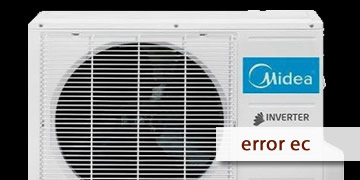Error EC on Midea Air Conditioner
Table of Contents

An alert on your Midea air conditioner showing error EC!
When your unit starts displaying error code EC, it’s like it’s saying, “Hey, I’m running low on refrigerant.” This code indicates that the system has detected a potential refrigerant leak, which directly affects its ability to cool properly.
Error EC appears when the system detects abnormal pressure in the refrigeration circuit. This usually happens because there’s less refrigerant than needed, often due to a leak somewhere in the system.
- Leaks can occur in several places: at the pipe connections, the service valve, the evaporator (indoor unit), or even the condenser (outdoor unit). Over time, some joints or solder points may degrade and allow the gas to slowly escape.
- Another possible cause is a problem with the pressure sensor or the electronics that control it. Although less common, it’s worth checking before assuming there’s an actual leak.
How to fix error EC on your Midea AC step by step
Here’s a short list of solutions for this issue. If you follow them carefully, you may be able to fix your air conditioner yourself:
- First, observe the symptoms: If in addition to the EC error, you notice that the air isn't cooling as it used to, or if the outdoor unit is frosting up, then there’s likely a refrigerant leak. These are clear signs that the refrigerant level is low.
- Try a system reset: Sometimes the error is temporary. Turn off the unit using the remote, unplug it for 10 minutes, then plug it back in and turn it on. If the error disappears but comes back shortly after, it confirms there's an actual problem and the unit needs to be checked.
- Inspect all visible connections on your air conditioner: With the unit turned off, take a close look at the pipes connecting the indoor and outdoor units. Look for oily stains (refrigerant usually leaves oily residue when it leaks) or areas with oddly accumulated dust, as escaping gas tends to carry particles with it.
- Check the service valve: This valve is located on the outdoor unit and is a common leak point. Make sure it's tightened properly and that there's no sign of moisture or corrosion around it. It's a good idea to disassemble it and clean it using electronic cleaner and a soft-bristle brush.
- Call a qualified technician: If you suspect a leak, now’s the time to call a professional. Fixing leaks and recharging gas isn’t a DIY task unless you’re trained in HVAC systems. These procedures require special tools and refrigerant handling skills, which only certified technicians are legally allowed to perform.
- Consider a full system inspection: A good technician won’t just fix the leak and refill the gas. They should also perform a pressure test to ensure there are no additional micro-leaks. They’ll also check the compressor and the filter drier, which can be damaged when the system runs on low refrigerant. You’ll also benefit from preventive maintenance that will extend the lifespan of your air conditioner.
To prevent this error from appearing again, make sure to schedule annual maintenance with a certified technician. Avoid exposing the units (especially the outdoor one) to strong impacts or vibrations. If the unit was recently installed, check that the installation was done correctly and keep an eye on any drop in performance.
This problem typically doesn’t lead to serious consequences if addressed early, as it's usually a simple repair. However, if ignored and the compressor continues running with low refrigerant, it could suffer permanent damage—leading to a much more expensive repair or even requiring replacement of the entire air conditioner.